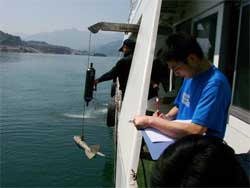
A multi-target and interdisciplinary investigation of the mighty Yangtze River's section between Chongqing and the reservoir stemmed by the giant Three-Gorge Dam has recently been completed by CAS researchers from the Institute of Hydroecology (IOH) and their collaborators.
A research center under the dual administration of CAS and the Ministry of Water Conservancy, IOH rallied scientists from various institutions to undertake the investigative expedition, including the Chinese Marine University and Chinese Academy for Water Conservancy and Hydropower, covering a total of 34 research topics in hydrology, water quality, eco-environment and hydrophilous wildlife.
The survey has so far obtained large numbers of first-hand data and specimens, providing solid backing for studies of a wide spectrum of subjects, including the long-term ecological effects imposed by large-scale waterworks on the Yangtze's major biological resources, countermeasures for the inquiry and management of the aquatic resources in the Three-Gorge Reservoir, a comprehensive investigation of the rare and endemic fish species in the upper reaches of the Yangtze.
The joint survey features an unprecedented integration of the existing research resources and high performance in addition to a multi-disciplinary or comprehensive coverage, according to experts. It excels the past similar surveying operations exclusively engaged in a single specialty. Besides, an initial analysis of the obtained data in sonar detection shows that the fishery resources in the Yangtze mainstream are remarkably more inferior than those in its tributaries. This revelation indicates the current mode adopted for the time being in utilizing and addressing the natural endowment needs a further and optimized facelift for ecological amelioration in the Three-Gorge Reservoir.





